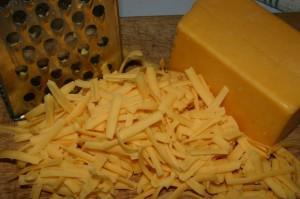What You Should Know About Cheese
 If you’ve ever looked at the ingredients in a package of cheese and seen the word “rennet,” you may be wondering exactly what that is.
If you’ve ever looked at the ingredients in a package of cheese and seen the word “rennet,” you may be wondering exactly what that is.
Rennet is the name of the ensymes in a young mammel’s stomach. These ensymes assist animals in digesting and absorbing their mother’s milk. These ensymes in fact separate milks into curds and whey, which is why it is so often used in cheesemaking. The catch is, in order to obtain these emsymes for cheesemaking, a young calf must be slaughtered so the rennet can be removed from its stomach lining (depending on the type of cheese being made, it may be a different type of baby animal being killed). Adult animals do not have this ensyme in their stomachs, so if a label says animal rennet, then it came from a baby animal.
To me, there is a difference between consuming meat, and consuming animal rennet. When an animal is raised for meat, it’s born, lives its life, (always look for the ones that have been humanely raised on open pasture), and grows to adulthood before it is slaughtered for consumption. When rennet is obtained, a very young calf is slaughtered for its stomach lining before it has a chance to have any kind of life. Usually the calves used for rennet are also used for veal, and veal calves have absolutely terrible lives (see my earlier post that talks about the raising of veal calves here)
Many of the cheeses on the market, and even many homemade ones, include rennet in the cheesemaking process. Sometimes it’s not always labeled as rennet, however. A tricky ingredient label is the word “ensymes.” Sometimes these are vegetable ensymes, sometimes it’s just a fancy word for animal rennet. Check with the company or cheesemaker to find out exactly what type of “ensymes” they’re using, whether they’re vegetable or animal derrived.
The good news is, you don’t have to stop eating cheese if you have morral issues with newborn calves being slaughtered for their stomach linings. There are alternatives to animal rennet available. Vegetable rennet is the best source of non-animal rennet. It’s made from a variety of plant ensymes, some of the most common being lemon and fig. There is also a type of rennet that is made from a type of mold, however, it’s not dangerous, as there is no actual mold in the finished product. It sometimes leads to a slightly bitter taste in the cheese, however.
One thing to watch out for, however, is FPC rennet. This rennet is techinally a GMO as a gene from bovine cells is injected into microbes to give microbes the ability to produce the ensymes found in animal rennet. Unfortunately, this type of rennet also gets a free pass, in that it doesn’t have to be specifically labeled. Even in many states that have GMO labeling laws, the FPC rennet does not have to be labeled as GMO, since the GMO orgsnism itself is not used in the cheese, only the ensyme that the organism produced. FPC rennet is now widely used in cheesemaking due to the ease with which it can be obtained.
One way to ensure that the non-animal rennet in the cheese is also non-GMO is to buy organic cheese. Currently the laws governing organic food do not allow GMO’s of any kind, even FPC rennet. Another way, as stated above, is to check with the company or cheesemaker themselves and find out exactly what type of rennet is going into their cheese. A little research can lead to a lot of peace of mind, and lot fewer babies slaughtered before their time.
If you’re looking for a place to start, Joyous Living has a list of non-animal rennet cheese brands here. Many of them are also organic, eliminating GMO-based FPC rennet. Copyright © Amber Reifsteck ~ The Woodland Elf
The information provided on this website is for general information purposes only. If you choose to rely on the information on this website, you do so at your own risk and you assume responsibility for the results. (Full disclaimer here)
Enjoy this post? Click here to subscribe by email and get new posts delivered to your inbox.Ads by Google







